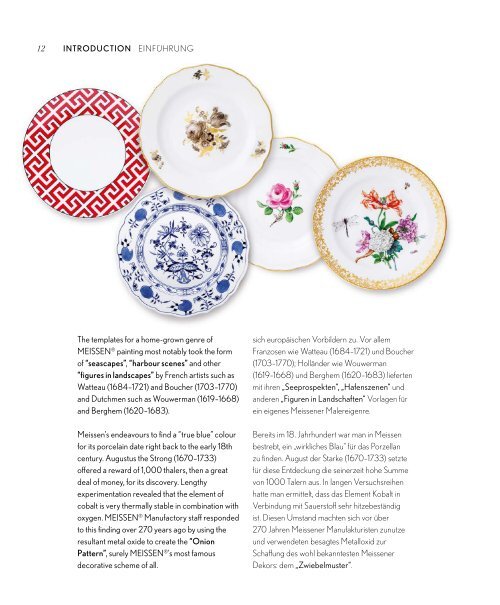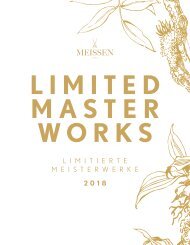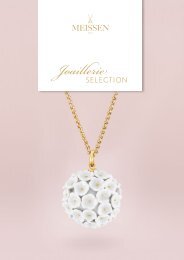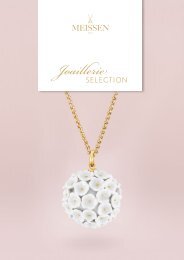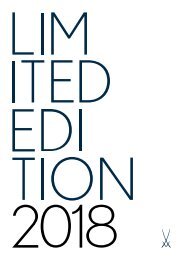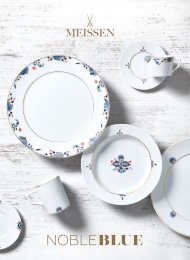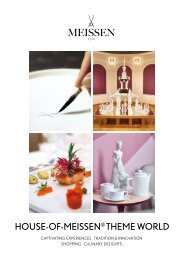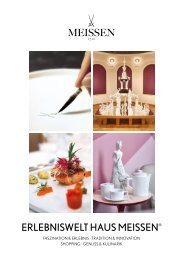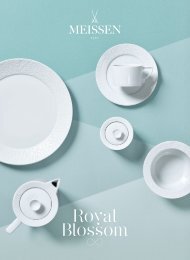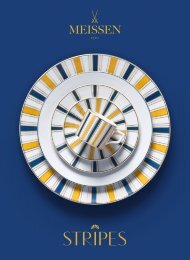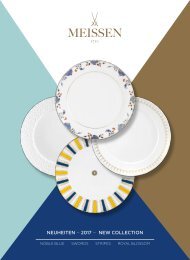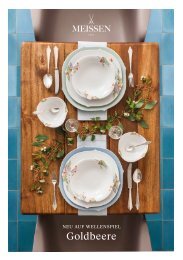MEISSEN Monkey Orchestra Asprey Edition
- No tags were found...
You also want an ePaper? Increase the reach of your titles
YUMPU automatically turns print PDFs into web optimized ePapers that Google loves.
12<br />
INTRODUCTION<br />
EINFÜHRUNG<br />
The templates for a home-grown genre of<br />
<strong>MEISSEN</strong> ® painting most notably took the form<br />
of “seascapes”, “harbour scenes” and other<br />
“figures in landscapes” by French artists such as<br />
Watteau (1684–1721) and Boucher (1703–1770)<br />
and Dutchmen such as Wouwerman (1619–1668)<br />
and Berghem (1620–1683).<br />
Meissen’s endeavours to find a “true blue” colour<br />
for its porcelain date right back to the early 18th<br />
century. Augustus the Strong (1670–1733)<br />
offered a reward of 1,000 thalers, then a great<br />
deal of money, for its discovery. Lengthy<br />
experimentation revealed that the element of<br />
cobalt is very thermally stable in combination with<br />
oxygen. <strong>MEISSEN</strong> ® Manufactory staff responded<br />
to this finding over 270 years ago by using the<br />
resultant metal oxide to create the “Onion<br />
Pattern”, surely <strong>MEISSEN</strong> ® ’s most famous<br />
decorative scheme of all.<br />
sich europäischen Vorbildern zu. Vor allem<br />
Franzosen wie Watteau (1684–1721) und Boucher<br />
(1703–1770); Holländer wie Wouwerman<br />
(1619–1668) und Berghem (1620–1683) lieferten<br />
mit ihren „Seeprospekten“, „Hafenszenen“ und<br />
anderen „Figuren in Landschaften“ Vorlagen für<br />
ein eigenes Meissener Malereigenre.<br />
Bereits im 18. Jahrhundert war man in Meissen<br />
bestrebt, ein „wirkliches Blau“ für das Porzellan<br />
zu finden. August der Starke (1670–1733) setzte<br />
für diese Entdeckung die seinerzeit hohe Summe<br />
von 1000 Talern aus. In langen Versuchsreihen<br />
hatte man ermittelt, dass das Element Kobalt in<br />
Verbindung mit Sauerstoff sehr hitzebeständig<br />
ist. Diesen Umstand machten sich vor über<br />
270 Jahren Meissener Manufakturisten zunutze<br />
und verwendeten besagtes Metalloxid zur<br />
Schaffung des wohl bekanntesten Meissener<br />
Dekors: dem „Zwiebelmuster“.


